5 Not-So-Intense Variations For Side Plank

(Photo: Rebecca Ferrier Photography )
Side Plank, or Vasisthasana in Sanskrit, is a pose that is revered by some, feared by others. It’s one of those poses that can find you off balance even when you are—or thought you were—feeling stable and aligned. Although the challenge increases when you’re working through physical issues of any sort (including exhaustion), you don’t necessarily need to rule this pose out from your practice. By making the necessary modifications and taking variations, you can radically shift both your perspective and your practice of Vasisthasana.
See also: 14 Modifications for Common Yoga Poses That You’ve Probably Never Seen Before
What are the benefits of Vasisthasana?
The physical practice of yoga is one of balance. Vasisthasana embodies that.
Balance is a key element in attaining, sustaining, and aligning in Side Plank, in both body and mind. According to Marco “Coco” Rojas, a yoga teacher who led packed classes in New York City for more than a decade and was named one of “America’s Most Influential Yoga Teachers” by Sonima, balance is inherent in the pose when you position yourself so your elbow and shoulder remain stacked in verticality. This alignment, says Rojas, helps you tap into the Sutras philosophy of finding stirum, typically translated from Sanskrit as “stability and ease.”
“When we bring the stirum into the forearm, so the wrist and elbow are aligned, the shoulder blade stays in optimal position, and we find the sukha in the shoulder,” explained Rojas. “And, sukha is what we want in life, so find it in the pose.” The concept of sukha is commonly explained as sweetness or ease, whereas dukha can be translated to discomfort or suffering. In both our physical practice of yoga asanas, along with our life experiences, one cannot exist without the other. We cannot fully experience a positive emotion if we haven’t gone through its opposite; in a similar fashion, if we can move past or modify the source of discomfort in a yoga pose, we then find ease and stability.
In its traditional expression, Side Plank relies on nuanced alignment, physical strength, stability, awareness, and mental discipline. All of these prerequisites can make—or have the potential to break—the connection between your physical body and your mind. Along with the complexities and challenges that can knock you off-kilter, the pose brings an array of benefits, including a sense of strength in your physical body, as well as the stamina to cultivate concentration and clarity in your mind.
Balance plays a role in all facets of our lives. Think of other balance-oriented poses, including Vrksana (Tree Pose), Sirsasana (Supported Headstand), and Navasana (Boat Pose). When a yoga pose reminds you of just how strong you are, that can reverberate throughout your life. Side Plank Pose not only strengthens your forearms, shoulders, elbows, and wrists, but because gravity is trying to pull you down, it also forces your core, abdominals, and back to activate and engage to maintain stability. When your physical and emotional selves are in balance, in turn, your energetic vibration is calm and stable. Fluidity and balance ensue.
Side Plank can also be helpful for those who experience certain types of back issues. Medical studies indicate that elongating and lengthening the spine, as demanded by this pose, can alleviate or provide some relief for back injuries, aches, pains, and other issues, including scoliosis.
See also: 15 Poses Proven to Build Better Balance
Modifications for Side Plank Plose
Modifying doesn’t mean doing less—it means adjusting accordingly. Respect your body and its boundaries, whatever that looks like for you in the moment. As you explore the following variations, ensure that you’re listening and responding to your body’s needs, not your mind’s desire. Without judgment or observation, practice the variation that suits your body’s ability. This alone is one of the most important parts of your unique yoga practice. According to the Yoga Sutras, now is the only time in which your practice can occur.
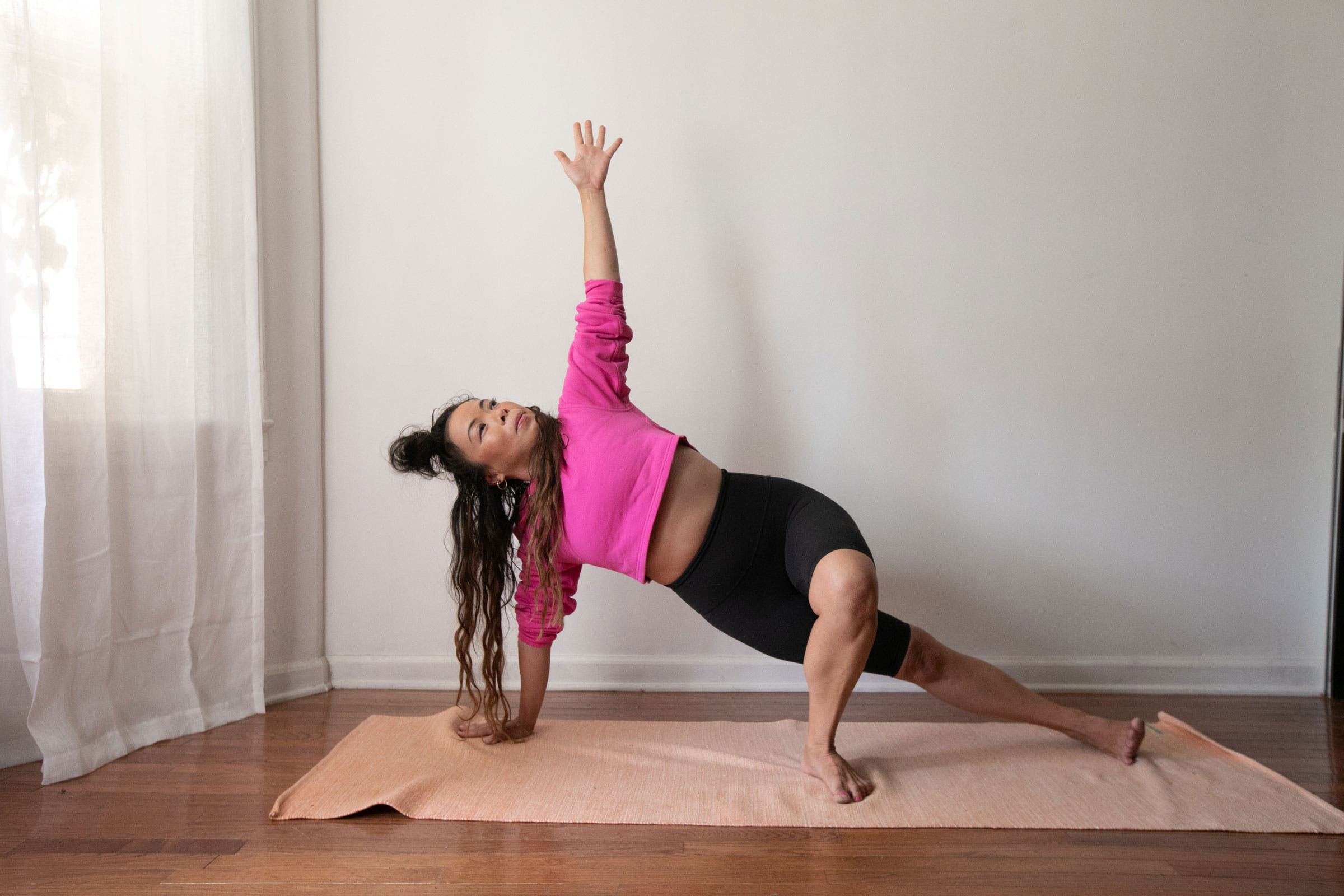
Side Plank Pose with one knee bent and foot in front
Why it helps: This variation is beneficial for those wanting a bit more stability and balance in their practice, or for those with tight hamstrings.
How to: Begin in Plank Pose. Come onto the outer edge of your right foot. Bend your left knee and place your left foot on the mat in front of your right knee. Ground the left foot and through the right palm. Extend the left arm up toward the ceiling in alignment with your right arm. Stay here for 5–7 breaths. Return to Plank. Repeat on the opposite side.
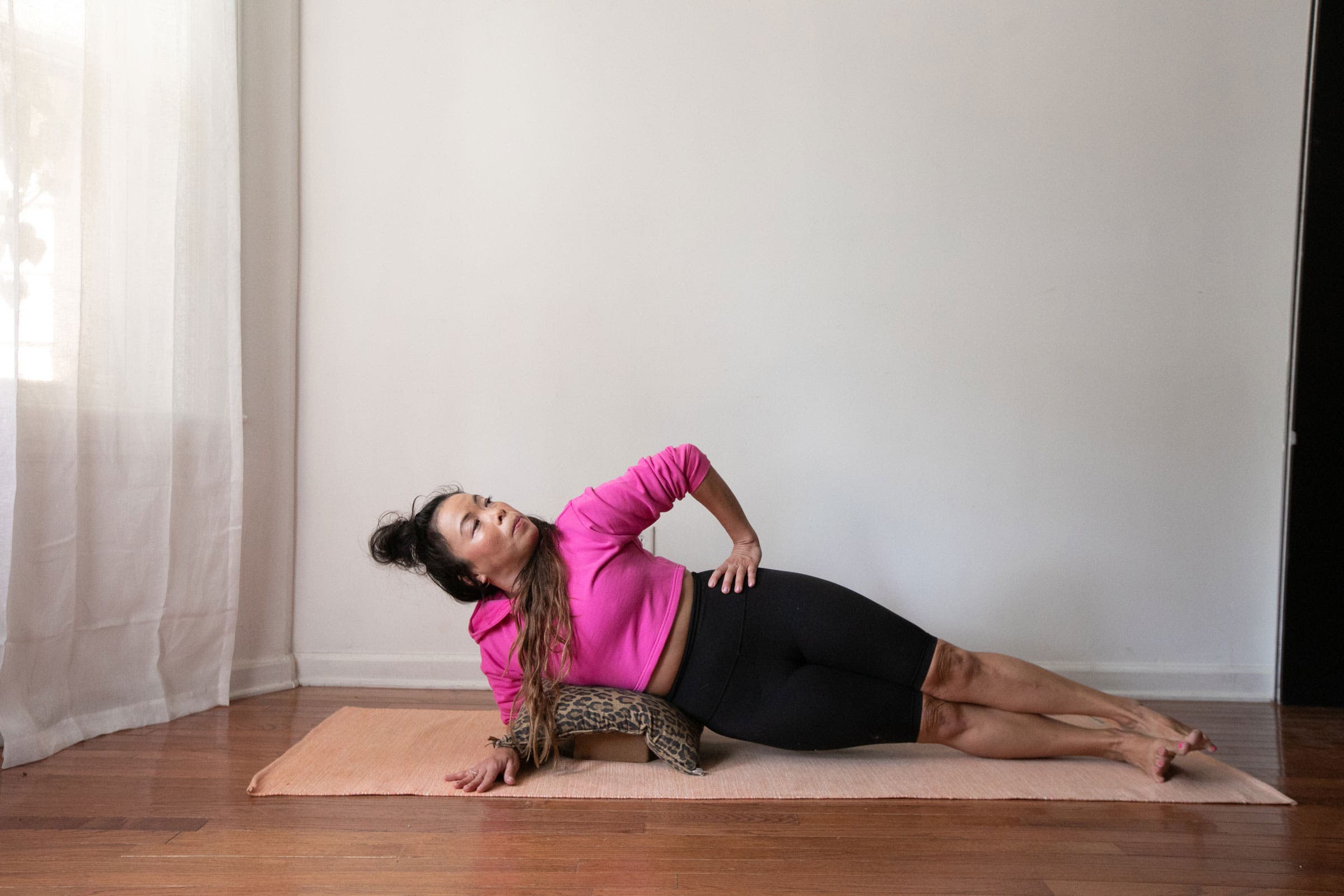
Side Plank Pose with hip support
Why it helps: For those recovering from hip injuries or experiencing tightness in the hips, the use of a prop supporting the hip can make the pose much more accessible and comfortable.
How to: Begin in Tabletop. Have a bolster (or a couple of pillows or blocks) in the center of the mat, underneath your pelvis. Straighten your right leg behind you with the ball of your foot on the mat, your toes tucked under, and your heel reaching back. Next, roll onto the outer edge of your right foot and rest your right hip and side body on the props. Place your left foot on your right or in front of your right hip or knee for stability. Your left palm can stay on your left or, if you feel supported and stable, reach your left arm up and stack your left shoulder directly above your right shoulder. Stay here for 5–7 breaths. Repeat on the opposite side.
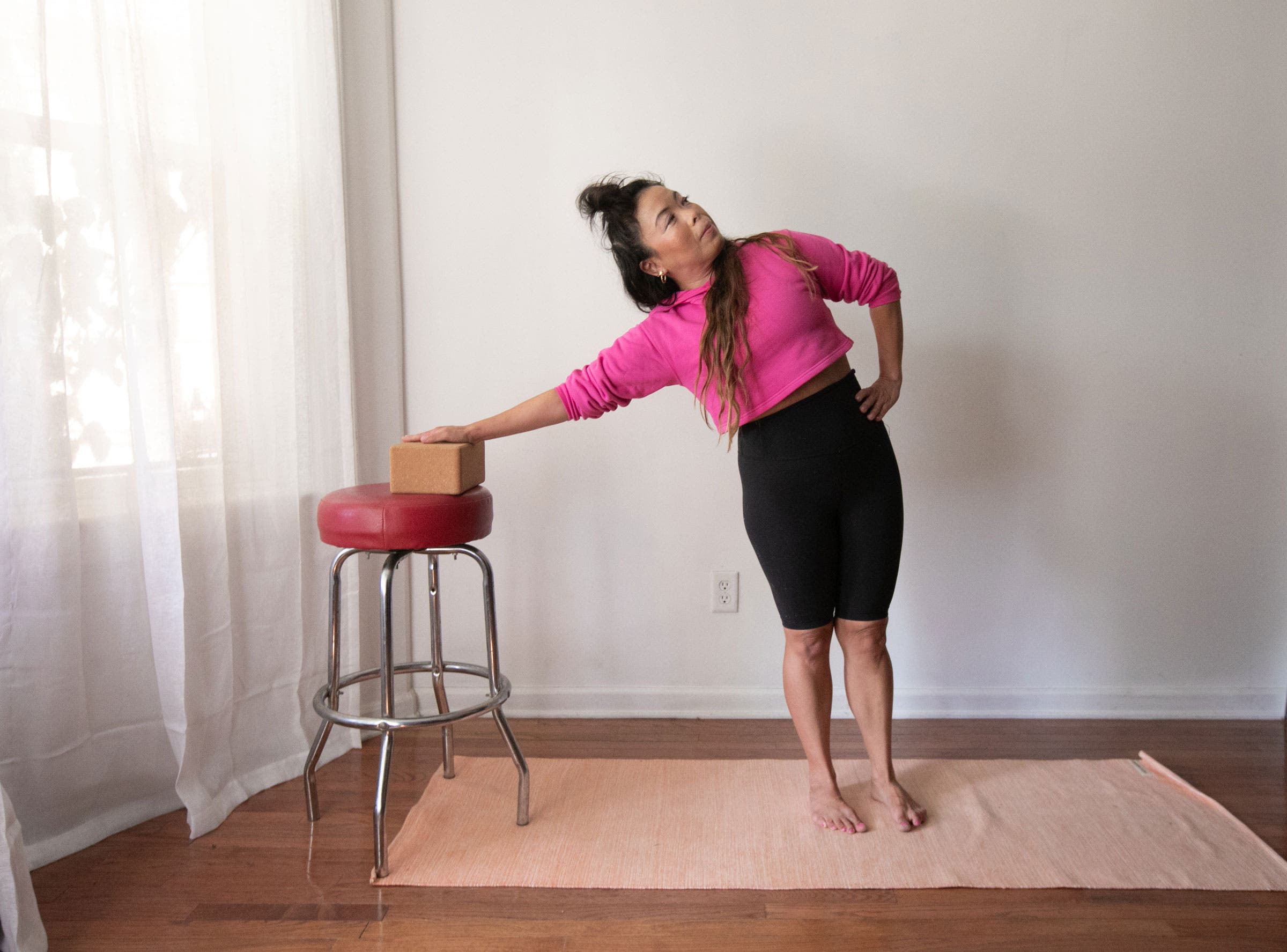
Side Plank Pose at a wall or with support
Why it helps: When you need an assist with your balance and/or less pressure, such as when you’re rehabbing an injury, you can rely on the wall or furniture (such as a couch, bed, chair, stool, etc.) to do some of the work for you.
How to: Stand with a wall or a couch, stool, chair, side table, or dresser on your right side. Extend your right arm out at a right angle to your body and let your right palm rest on the wall or support at shoulder height or a little lower. Bring your right foot in line with your right hand and parallel to the wall or furniture. Next, bring your left foot next to your right foot. Bring your left hand to your left hip or extend your left arm straight out to the left side, fingers and palm facing away from you. Stay here for 5–7 breaths. Repeat on the opposite side.
See also: 8 Common Yoga Poses That Are Easier to Teach (And Learn) at the Wall
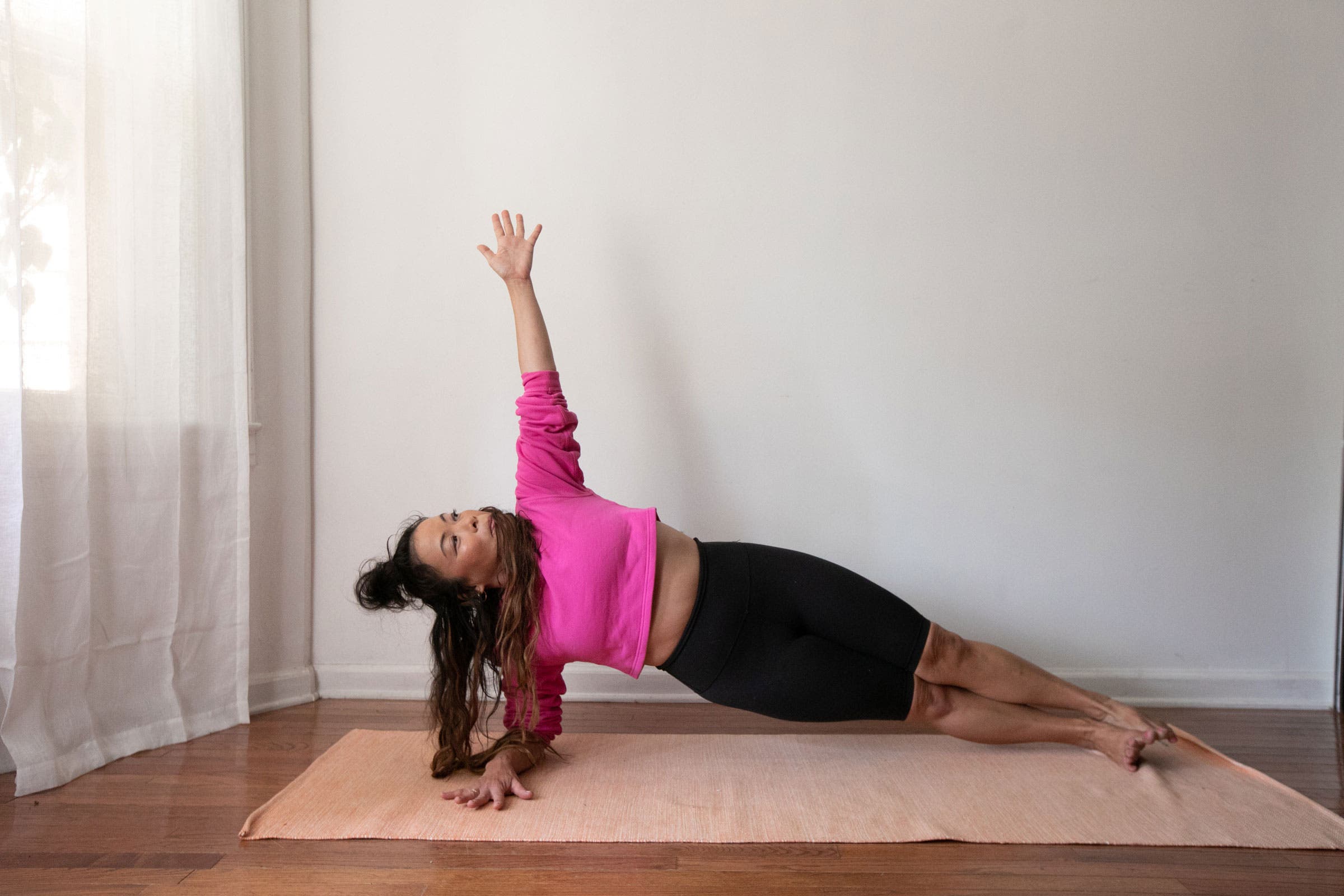
Side Plank Pose with the forearm at an angle
Why it helps: This variation can benefit those who are working with certain shoulder issues, such as alignment and stabilization of the rotator cuff and shoulder joint, or for those looking to stay away from putting excess pressure on the wrists. However, this variation does put more pressure on the shoulders, forearms, and elbows, and should be avoided if it’s too much for your practice at the moment.
How to: Begin in Forearm Plank Pose with forearms, elbows, and palms pressing evenly into the mat and parallel to the long the side of the mat. As with traditional Plank Pose, the joints should be aligned with one another, except here it’s the elbows and wrists. Check that your shoulders are stacked directly over your elbows. Press down evenly through your forearms and palms. Look down at your right forearm and pivot on the elbow until your right forearm is parallel to the short side of the mat. Come onto the outer side of your right foot and stack your left foot on top. You can keep your left arm alongside your body or, if you feel steady, extend it toward the ceiling with your palm facing away from you. Engage your abdominals and breathe. Stay here for 5–7 breaths. Return to Forearm Plank or take a moment in Child’s Pose to recalibrate. Repeat on the other side.
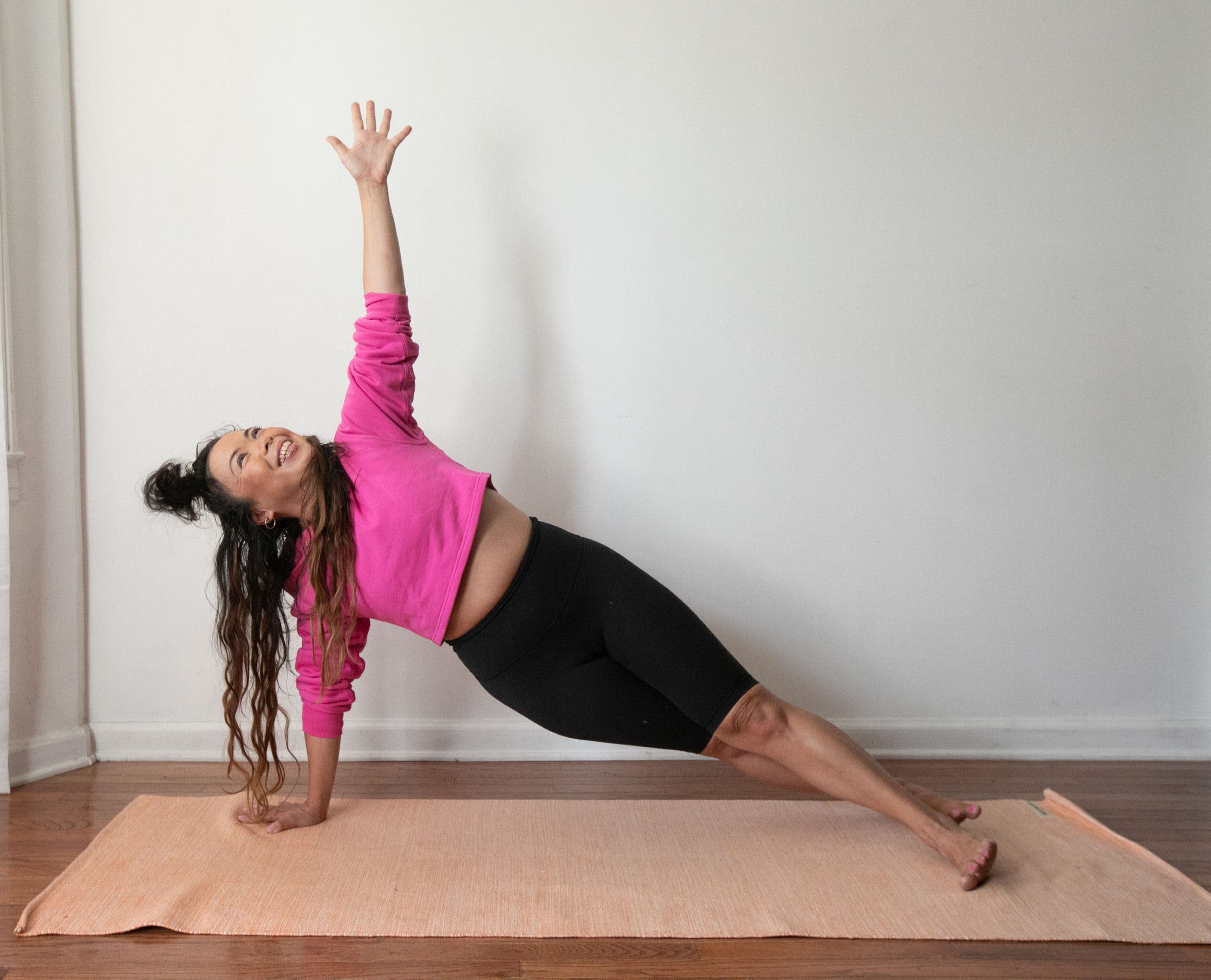
Side Plank Pose with one foot in front
Why it helps: In this variation, those with weakness or instability in the ankles might find it helpful to establish balance.
How to: Begin in Plank Pose by bringing your shoulders directly over your wrists with the joints stacked in vertical alignment. Be sure your right hand is in line with your right ankle and your left hand and foot are aligned. Press your right palm evenly into the mat as you roll onto the outer side of your right foot. Place your left foot on the mat in front of your right knee for more stability. Ground down through your left foot and through your right palm. Your left palm can stay on the left hip or extend your arm in alignment with your right arm. Stay here for 5–7 breaths. Return to Plank Pose. Repeat on the opposite side.
See also: 5 Poses to Strengthen Your Lower Back and Core—All Without Standing Up